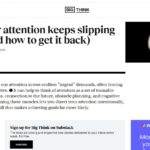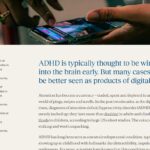
In the mentally hazy email catchup that is my typical Saturday morning, I found two articles on attention that deserve your…. well…..attention.
My Saturday mornings usually involve a bit of learning. I catch up on the emails and resources I’ve saved during the week, and I make entries in my learning journal. This past weekend, one theme kept popping up over and over again: attention.
Over the last few years, I’ve noticed more people opening up about their attention struggles. For some, it’s relatively mild, manifesting as difficulty staying on track, more procrastination than is usual, or constantly feeling “scattered.” For others, it’s more significant and leads to a diagnosis of ADHD. At Flinders, we’ve seen this reflected in the significant popularity of the ADHD support group and the formation of the Neurodiversity Community Program (which includes ADHD). And in the wider world, there’s been a surge of discussion, articles, and personal reflections about how our attention is being stretched thin. Attention was even the topic of a recent tip sheet I created.
Two pieces I read this weekend (20th September) that particularly stood out are worth sharing.
 The first, from Big Think, explored why attention feels so fragile in modern life. It’s not just about “bad habits”. Our environment is designed to scatter us, with notifications, endless tasks, and competing demands. But here’s the good news: attention isn’t fixed. Think of it as a set of muscles you can train. The article describes four such “attention muscles”: visual focus (the ability to zoom in or out on what matters), temporal connection (linking what you’re doing now to your future goals), obstacle-processing (anticipating distractions or setbacks and planning for them), and cognitive flexibility (switching between different mental modes to keep the mind fresh). The implication is that by deliberately exercising these muscles, through habits, planning, and environment design, you can strengthen your ability to focus. Read here.
The first, from Big Think, explored why attention feels so fragile in modern life. It’s not just about “bad habits”. Our environment is designed to scatter us, with notifications, endless tasks, and competing demands. But here’s the good news: attention isn’t fixed. Think of it as a set of muscles you can train. The article describes four such “attention muscles”: visual focus (the ability to zoom in or out on what matters), temporal connection (linking what you’re doing now to your future goals), obstacle-processing (anticipating distractions or setbacks and planning for them), and cognitive flexibility (switching between different mental modes to keep the mind fresh). The implication is that by deliberately exercising these muscles, through habits, planning, and environment design, you can strengthen your ability to focus. Read here.
The second, from Psyche, argues that we may be talking about more than one kind of ADHD, or attention dysregulation more broadly. It suggests two distinct forms. Type I is the “classic” neurodevelopmental version, present from early life, often highly genetic, and typically responsive to medication plus structure. Type II is more environmentally driven, emerging in the age of screens, constant alerts, and fragmented digital habits. This type may be less responsive to medication but more helped by lifestyle and behavioural changes such as reducing digital overload and reshaping how we interact with technology. Read here.
The second article, in particular, resonated with me as I don’t think I had any attention issues as a child, but I can certainly see, how over the years, my attention has taken a hammering from the digital environment in which I live, the constant news cycles, the unending information flows you can tap into, and the expectation of being always ‘on’ and connected with what is happening. It doesn’t surprise me at all, the idea that ADHD could be an internal manifestation of the chaotic nature of the modern world. So much so that for my upcoming monthly challenges (I try to improve myself 1 month at a time), I will be focusing on activities to restore my attention capacity (meditation, digital restrictions, book reading).
If you want to join me, here are some of the attention training processes described in the two articles.

From Big Think (attention “muscles”)
-
Visual focus muscle
-
Practise zooming in on a single task or object.
-
Experiment with narrowing or widening your focus (e.g. blocking out distractions to work on one thing; or scanning more broadly to notice connections).
-
Use visualisation (e.g. imagining goals as closer or more tangible to increase motivation).
-
-
Temporal connection muscle
-
Connect present actions with long-term goals or your “future self.”
-
Use mental imagery of what success will look and feel like.
-
Ask: How does this task serve the person I want to become?
-
-
Obstacle-processing muscle
-
Don’t just fantasise about the goal — anticipate obstacles.
-
Use “if–then” plans (implementation intentions). Example: If I feel the urge to check my phone, then I will place it out of reach until the task is done.
-
Normalise setbacks and prepare strategies for when they arise.
-
-
Cognitive flexibility muscle
-
Switch between different mental tasks to train adaptability.
-
Engage in activities outside your main work (e.g. puzzles, drawing, playing music, going for a walk) to refresh attention networks.
-
Practise reframing problems from multiple angles.
-
From Psyche (Type II ADHD / lifestyle-driven attention dysregulation)
-
Reduce screen overload
-
Limit constant notifications and alerts.
-
Introduce device-free periods during the day.
-
Use apps/settings that block distractions during focus time.
-
-
Rebuild focus habits
-
Work in defined blocks (e.g. Pomodoro or deep work sessions).
-
Practise monotasking — doing one thing at a time until completion.
-
Set intentional routines that don’t rely on constant switching.
-
-
Create healthier digital environments
-
Curate your digital feeds to reduce noisy, fast-switching input.
-
Reserve screens for specific purposes, rather than endless scrolling.
-
Prioritise offline activities that build sustained attention (reading, physical activity, creative hobbies).
-
-
Lifestyle supports
-
Ensure good sleep, nutrition, and physical activity — all of which stabilise attention.
-
Build structures of accountability (study groups, shared goals, or scheduled focus times with others).
-
Balance stimulation with rest — too much or too little can impair focus.
-
In the end, it might be helpful to think of attention as a trainable capacity rather than a fixed trait. This could be by strengthening your “attention muscles” (through focus, connecting tasks to goals, planning for obstacles, and practising flexibility) or shaping your lifestyle to cut down on digital noise and create healthy routines.
And the need to do this is created by the fact that our world (for better or worse) is designed to hijack our attention. So learning to gently bring it back might be one of the most valuable skills you can build.

It’s one thing to read a list of tips or recommendations, and another to actually make a change in your life.
Often we assume the “how” is obvious, but for many people it isn’t, especially when you’re new to this kind of self-experimenting.
So here’s a quick checklist to help turn an idea into action:
-
Be specific about the change – define exactly what you’ll do.
-
Set a test time period – give yourself a clear window to try it (e.g. one week).
-
Build capability – learn what you need to know first (read more, ask someone, look up instructions).
-
Find the opportunity – identify when and where it will fit into your life.
-
Consider involving others – peers, friends, or partners can add accountability and encouragement.
-
Choose something that sparks curiosity – if motivation is low, make the behaviour as small as possible.
-
Focus on experimentation, not perfection – most of us live in complex systems, so the goal isn’t picking the “perfect” behaviour but starting somewhere and seeing what happens.
-
Reflect and adjust – at the end of your trial, notice what worked, what didn’t, and what surprised you.
-
Stack it with habits you already have – it’s easier to add a new behaviour if you tie it to something you already do.
For example, take the recommendation to “reduce screen overload by introducing device-free periods during the day.” That could look like this:
-
Specific change: Put my phone in another room for the first 30 minutes after I wake up.
-
Test time period: 1 week.
-
Capability: Learn how to set “Do Not Disturb” so only essential calls get through.
-
Opportunity: Use the time for breakfast, stretching, or planning the day.
-
Peers: Let a friend know I’m trying this so they don’t expect instant replies in that window.
-
Motivation: I’m curious if starting the day screen-free makes me feel less rushed.
-
Experimentation: After a week, reflect on how it felt, and decide whether to extend, adapt, or drop it.
The big takeaway is that the value isn’t in reading about change, but in trying it out in a small, structured way. Every attempt gives you feedback you can build on, and over time those small experiments add up to lasting improvements in focus and wellbeing.
I hope that helps.


